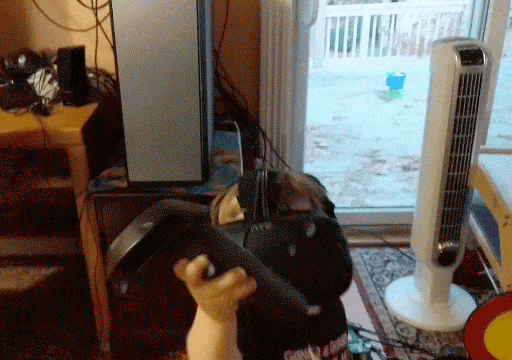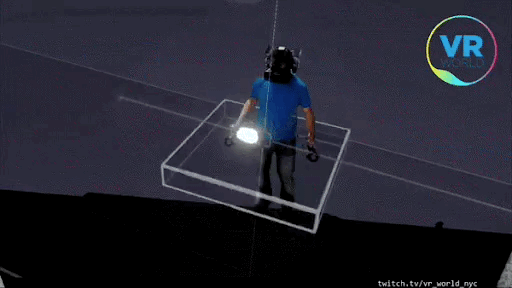Alex Coulombe is a very busy VR/AR architect guy over in NYC. Logan is a West Coast version of him-- more relaxed and more bearded.
By day Logan and Alex are XR technologists. By night they’re XR dads.
Alex on XR Dad:

So Alex, how did you and your XR Dad cohost Logan get together?
When Logan and I first met in June 2017, it was very cool to see how much our interests aligned, to the point where we were even creating similar companies. Turns out this shared interest even extended to how we wanted to raise our kids.
What’s the elevator pitch for Agile Lens?
We build custom XR solutions for the built environment.
And why did you want to be an XR Dad?
I didn’t. Logan is making me do this.
Oh. Really?
Kind of. But I’m glad! There is a lot to offer parents and anyone dealing with kids and immersive tech. Most people are hesitant about introducing XR because there hasn’t been time to conduct in-depth studies of the effect it may have on developing minds. I think with that hesitancy comes a lot of missed opportunities.
What’s your general philosophy on showing kids XR?
That is should be with a purpose and for extremely limited amounts of time. Like TV, like tablets, like anything with a screen, it should never be treated as a babysitter, but supervised and used to teach specific concepts that the medium is well suited for.

What would be an example of a concept that is easier to understand in XR?
I’ll give you two: 1) scale. Alasdair, my 3 year old, loves dinosaurs. It's amazing to give him a sense of just how big a T-Rex or a Diplodocus actually was. 2) travel. This past year I’ve been to Venice, London, San Francisco, Los Angeles, and of course, NYC. I love being able to use something like Google Earth VR or other even more targeted experience to give him a sense of what my trips entail. In fact, I’ve started using a Mirage Solo 180 VR camera for stereo photos/video so if I, say, go for a bike ride along the Thames, he can put on a VR headset and see exactly what that was like.
Is there anything with XR and kids you worry about?
Certainly—making the wonders of the real world less exciting. I went for a hike with Alasdair and at the end there was a pond where you could feed fish. You’d throw some food in and every so often see a little splash when they came up to eat. He seemed unimpressed by this, likely because just a couple days before I’d shown him theBlu, which puts you underwater while many fish, as well as a full-size blue whale, swim right by you. Tough to top.
And yes, I just want to emphasize that there is a very real possibility that over-exposure to XR may impact developing vision, so please people, do be mindful. With XR, a little goes a long way to communicate complex ideas.
When did you first see the potential of XR to do that—communicate complex ideas?
There were two moments. In 2009 I was working on my architecture thesis which involved transforming Fort Jay on Governors Island into a crazy, inverted panopticon theatre thing. An Augmented Reality plugin called AR-Media (which simply used my webcam and an image marker) was instrumental in showing some of the intricacies of my design and how it would function.
The second epiphany came with the Oculus Rift DK1 in 2013. I was designing theatres with Fisher Dachs Associates, and as part of that process, we would check sight-lines in plan, section, and 3D perspectives. There was often frustration on our side of communicating these spatial relationships with 2D mediums— someone might think the stage looked too far away or the head of the person in front of you was too close. As soon as VR allowed us to drop someone into a theatre and feel like they were inside it, those questions went away and we were able to focus more on the design itself.


How do you think an XR experience seen by a kid compares to the same experience as an adult?
Kids have little sponge brains and soak up new concepts so quickly. As an adult, your neural pathways are more set and you have a more rigid way of interpreting the world and its possibilities. For example, when I introduce an adult to Tilt Brush for the first time, they typically draw around them as though there’s a flat piece of paper out there, and usually need to be told they can move around.

A kid in Tilt Brush draws with their whole body, moves constantly through their space, and is positively thrilled to try new brushes and colors. Any XR creation tool allows for them to extend their imaginations beyond what they might be able to do with crayons or paint in the real world (it’s also a lot cheaper). But really just about any kind of training or education—from history to math to science can benefit from XR material.

Kind of an expensive investment for the average classroom though, isn’t it?
Not necessarily. A lot of people don’t know that a Windows Mixed Reality headset can operate any Oculus or Vive experience, and is easier to set up due to its inside-out tracking. Oftentimes it’s also a lot cheaper-- on a good day you can find an WMR headset with controllers used for less than $100. Google Cardboards are still super cheap, and can be used to view plenty of free content from sources like Sketchfab, YouTube, or Google Expeditions.
What do you want to see in the future for XR education?
I’m still looking forward to realizing those Magic Leap concept videos allowing for shared classroom experiences of a whale on a gymnasium floor or fully-interactive report on Mount Everest. Until then though, there’s a lot of education to be done about the education possible in XR. I think we can start there. Does that make sense?
Totally.
Subscribe to XR Dad for the rest of the interview and be the first to get access to free games and apps the dads are making for their kids and their grownups. Share them with your niece--or that one guy in the office who still doesn't get why AR is a"thing."
